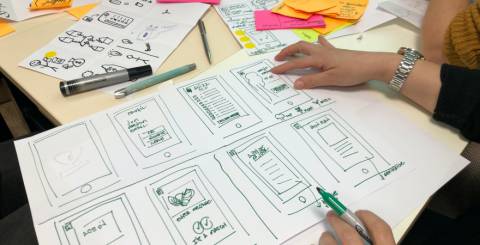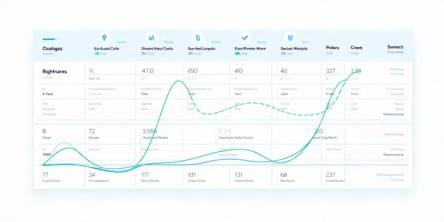Application Development Trends For Business

With over 6.3 billion estimated smartphone users worldwide, mobile app usage is growing exponentially. Studies have shown that Americans check their phones 262 times daily, once every 5.5 minutes! People check their phones at home, at work, on the street, while eating, in bed, and in cars. An estimated 88% of the time is spent on apps. This kind of statistics makes app development the right tool for improving business.
Some key statistics
- Mobile apps are expected to generate over USD 935 billion in revenues by 2023.
- On average, mobile phone users open ten apps daily and 30 apps /per month.
- Mobile apps account for almost 70% of all US digital media time.
Some top mobile app development trends that can help business increase their visibility and revenues -
5G: The 5th generation of mobile is here and is all set to make its mark. It's said to be the usher in the fourth industrial revolution. The adoption of 5G for mobile apps is about speed and interconnectivity. Its latency is supposed to be less than one millisecond, which is instantaneous compared to a human reaction time of 300 milliseconds. Its combination of low latency, high bandwidth & connectivity density will help open up app development in areas like IoT, AR / VR, connected driverless vehicles, wireless health and more. Its higher frequency and short wavelength enable better geo-targeting and geofencing for mobile apps.
Edge computing: Cloud computing and big data have proved to be highly beneficial to businesses. Once hailed as the biggest perk of the internet, the cloud is beginning to show signs of slowing down as its centralized processing can create a latency that may not be able to keep up with the 5G technology. Edge computing is beginning to come of age and is an evolution in cloud technology. Edge computing "moves" the cloud near the user by processing the computational needs locally or at the nearest point, called the "edge". Once edge computing is widely adopted, the user device becomes a part of the cloud. B2B mobile app trends are already showing the rising importance of edge computing. The mobile edge market value is expected to reach USD 2.8 billion by 2027. The global edge computing market is can witness massive growth and reach USD 12 billion by 2028 from USD 3 billion in 2020.
Progressing Web Apps (PWA) and instant apps: PWAs or Progressive Web Apps, seen as the next big thing to happen in app development, are a hybrid of web pages and apps. They take less time to develop than regular apps as they are typically websites with app functionalities and counter the disadvantages of native applications. PWAs have a low degree of dependency on the internet, need less time for loading & have low storage needs. They are highly accessible, adaptable, and updated automatically.
Many B2B and B2C businesses reported an increase in conversion rates, engagement rates, sales and revenue upon launching PWA platforms during the Covid-19 pandemic because of the exponential rise in online shopping.
Beacon technology: Launched in 2013, this technology has grown and advanced significantly from Apple's low-energy Bluetooth device to being a globally recognized and adopted technology. ResearchDive suggests that the global beacon technology market is projected to grow at a CAGR of 45.5% during 2019-2024 to reach $ 10.2 billion by 2024. Beacons offer personalized experiences and customers are more likely to engage with a product that is advertised to them directly. Native apps capitalize on beacon technology and can integrate seamlessly with the beacon signal and enhance interaction between the brand and customer.
Artificial intelligence (AI): Machine learning (ML) can help in reducing app development time significantly. The latest mobile user interface (UI) designs are developed using AI using the concept called "computational design," implying that the app interfaces can be made by automated programs and not necessarily by a design team. This concept underlines the use of AI and ML to speed up the design process. AI design programs can have a clear set of parameters that mimic the human decision-making process ensuring minimal variation in results.
Touchless UI: It is one of the emerging trends in mobile app development that is popular among application users. A Gartner forecast suggests that by 2023 almost 50% of all big business apps will include at least one type of touchless UI experience.
Low code app development: The frameworks help speed up the development process. A low- or no-code platform allows companies to design and develop an app without coding experience. Such systems can help reduce app development time and complexity. Low-code or no-code app development is relatively easy and uses drag-and-drop actions and intuitive UI to create an app. Such platforms can enable businesses to develop first-generation apps without hiring developers or outsourcing app development.
Some other trends that will make an impact on the app development scene for business are -
- Wearable app development
- mCommerce
- More on-demand apps
- AI
- Bots
- Personal smart-hubs
- AR and VR
- Accelerated mobile pages
- Blockchain
- Predictive analytics
- Cross-platform apps
In conclusion, a mobile-centric ecosystem dominates the landscape, with technologies like 5G, edge, wearables & more leading the charge. Mobile app development is challenging, and businesses should consider varied factors. It would include target audience, business sector, size, products, services & more to hire mobile application development services which can research and develop the best-in-class mobile apps for business improvement and success.
Similar Articles
Food delivery applications, including Uber Eats, DoorDash, Zomato, Swiggy, and Grubhub, generate large volumes of valuable data.
Modern businesses are drowning in communication overload, and much of that burden stems from outdated tools that simply can’t keep up
Building lending software isn’t just a technical project—it’s a business decision. Whether you're a fintech founder or part of a traditional lending institution trying to go digital, three questions will shape everything that follows
Learn why robust security is crucial for super app development. Explore key strategies and best practices for mobile app development security.
Walkie-talkies with an extensive reception capacity have changed significantly when it comes to portable communication by displaying cutting-edge features with seamless connectivity that covers more than just the state
USB-C technology has revolutionized the way we charge our devices, offering faster charging speeds, higher power delivery, and universal compatibility across multiple devices
Discover expert mobile app development strategies to create a viral app that attracts users and boosts engagement
Optimize app localization for iOS users across the EU with language, cultural, and regulatory adaptations. Engage users and boost retention with these tips!
Discover the top 10 mobile app development trends of 2024! Explore 5G, AI, AR/VR, blockchain, and more to stay ahead in the ever-evolving app development landscape.









